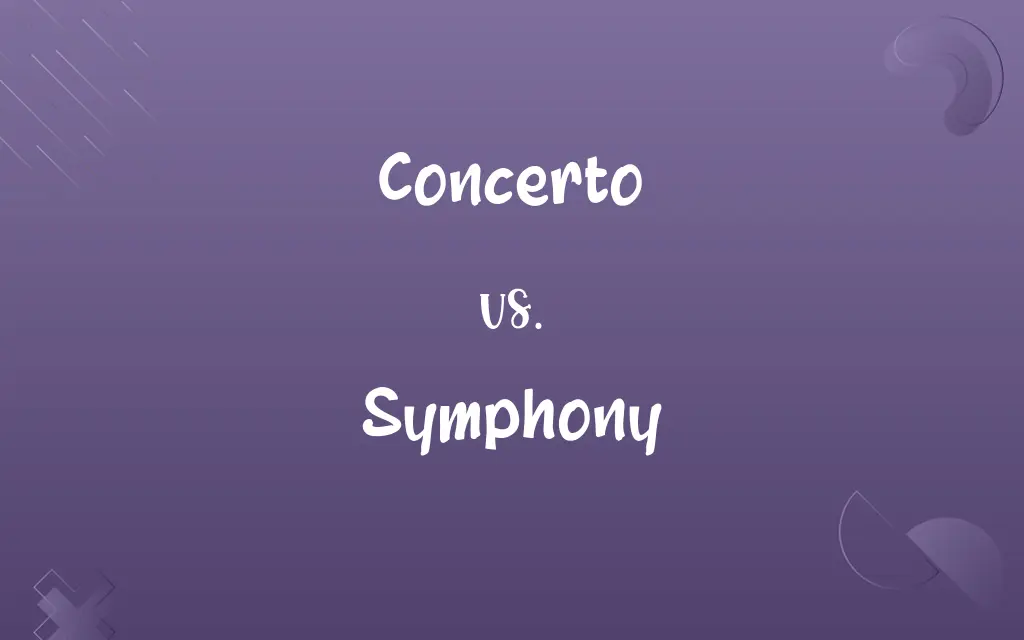Concerto vs. Symphony: Know the Difference

By Shumaila Saeed & Dua Fatima || Updated on March 5, 2024
A concerto focuses on a soloist or soloists with orchestral accompaniment, showcasing individual artistry, while a symphony is an orchestral composition in multiple movements, emphasizing the ensemble's collective sound.

Key Differences
A concerto is a musical composition designed to display the virtuosity of a solo instrument or group of instruments, accompanied by an orchestra. On the other hand, a symphony is an extended musical composition for orchestra in several movements, aiming to explore the depth and breadth of orchestral sound without focusing on a single solo instrument.
Shumaila Saeed
Mar 05, 2024
Concertos often feature a clear dialogue between the soloist and the orchestra, with the solo parts written to highlight the performer's skill and expressive capabilities. Whereas, symphonies present a unified body of sound, with themes and motifs developed across various movements, each contributing to the work's overall narrative or emotional journey.
Shumaila Saeed
Mar 05, 2024
The structure of a concerto typically includes three movements (fast-slow-fast), providing a framework for showcasing the soloist's technical prowess and musicality. Symphonies, while also frequently adopting a four-movement structure (fast-slow-dance-like-fast), serve to explore thematic development and orchestral color in a more comprehensive manner.
Shumaila Saeed
Mar 05, 2024
Historically, the concerto has evolved from Baroque concerti grossi to Classical and Romantic era masterpieces, where the focus shifted to individual expression and virtuosity. Symphonies underwent significant development over the same periods, expanding in scope and complexity, and becoming the pinnacle of orchestral achievement, particularly from the Classical period onwards.
Hifza Nasir
Mar 05, 2024
While concertos and symphonies share common elements such as movement structure and orchestral forces, their goals diverge significantly. Concertos celebrate the individual, often the composer or a dedicated virtuoso, while symphonies embody the collective, exploring the possibilities of orchestral sound and composition.
Hifza Nasir
Mar 05, 2024
ADVERTISEMENT
Comparison Chart
Definition
A composition for one or more soloists and orchestra
An extended work for orchestra in multiple movements
Shumaila Saeed
Mar 05, 2024
Focus
Soloist's virtuosity and interplay with orchestra
Orchestral ensemble and thematic development
Dua Fatima
Mar 05, 2024
Typical Structure
Three movements (fast-slow-fast)
Four movements (fast-slow-dance-like-fast)
Shumaila Saeed
Mar 05, 2024
Historical Evolution
From concerti grossi to solo concertos highlighting individual expression
Expanded in complexity, becoming a central form of orchestral music
Shumaila Saeed
Mar 05, 2024
Purpose
Showcase soloist's skill and musical expression
Explore orchestral sound and thematic continuity
Dua Fatima
Mar 05, 2024
ADVERTISEMENT
Concerto and Symphony Definitions
Concerto
A musical piece spotlighting a soloist's skill with orchestral accompaniment.
Vivaldi's Four Seasons showcases violin artistry.
Shumaila Saeed
Mar 05, 2024
Symphony
An expansive orchestral composition exploring thematic development.
Beethoven's 9th Symphony is known for its complexity and choral finale.
Shumaila Saeed
Mar 05, 2024
Concerto
Balanced interplay between soloist and ensemble.
Beethoven’s Violin Concerto demonstrates dialogue between violin and orchestra.
Shumaila Saeed
Mar 05, 2024
Symphony
Encompasses a broad emotional and musical range.
Tchaikovsky's Symphony No. 6 explores profound emotional depth.
Dua Fatima
Mar 05, 2024
Concerto
Allows individual expression within an orchestral context.
Rachmaninoff's Piano Concerto No. 3 highlights the pianist's virtuosity.
Hifza Nasir
Mar 05, 2024
ADVERTISEMENT
Symphony
Often structured in four movements with thematic continuity.
Brahms' Symphony No. 1 features motifs evolving across movements.
Dua Fatima
Mar 05, 2024
Concerto
Often features a cadenza where the soloist performs freely.
The cadenza in Mozart's Clarinet Concerto is a focal point for solo creativity.
Shumaila Saeed
Mar 05, 2024
Symphony
Utilizes the full orchestra to achieve a unified sound.
Mahler’s Symphony No. 1 showcases orchestral color and dynamics.
Shumaila Saeed
Mar 05, 2024
Concerto
Structured typically in three movements.
Brahms’ Violin Concerto adheres to the classic fast-slow-fast format.
Shumaila Saeed
Mar 05, 2024
Symphony
Represents the pinnacle of orchestral music.
Dvorak's New World Symphony combines traditional symphonic form with new themes.
Shumaila Saeed
Mar 05, 2024
Concerto
(music) A piece of music for one or more solo instruments and orchestra.
Shumaila Saeed
Oct 19, 2023
Symphony
An extended piece in three or more movements for symphony orchestra.
Shumaila Saeed
Oct 19, 2023
Concerto
A composition (usually in symphonic form with three movements) in which one instrument (or two or three) stands out in bold relief against the orchestra, or accompaniment, so as to display its qualities or the performer's skill.
Shumaila Saeed
Oct 19, 2023
Symphony
A stringed instrument formerly in use, somewhat resembling the virginal.
With harp and pipe and symphony.
Shumaila Saeed
Oct 19, 2023
Concerto
A composition for an orchestra and one or more solo instruments, typically in three movements.
Shumaila Saeed
Oct 19, 2023
Symphony
An extended piece of music of sophisticated structure, usually for orchestra.
Shumaila Saeed
Oct 19, 2023
Symphony
Harmony in music or colour, or a harmonious combination of elements.
Shumaila Saeed
Oct 19, 2023
Symphony
A consonance or harmony of sounds, agreeable to the ear, whether the sounds are vocal or instrumental, or both.
The trumpets sound,And warlike symphony in heard around.
Shumaila Saeed
Oct 19, 2023
Symphony
(music) An instrumental introduction or termination to a vocal composition.
Shumaila Saeed
Oct 19, 2023
Symphony
A large orchestra; can perform symphonies;
We heard the Vienna symphony
Shumaila Saeed
Oct 19, 2023
Symphony
An elaborate instrumental composition for a full orchestra, consisting usually, like the sonata, of three or four contrasted yet inwardly related movements, as the allegro, the adagio, the minuet and trio, or scherzo, and the finale in quick time. The term has recently been applied to large orchestral works in freer form, with arguments or programmes to explain their meaning, such as the "symphonic poems" of Liszt. The term was formerly applied to any composition for an orchestra, as overtures, etc., and still earlier, to certain compositions partly vocal, partly instrumental.
Shumaila Saeed
Oct 19, 2023
Repeatedly Asked Queries
What role does a cadenza play in a concerto?
A cadenza offers the soloist a moment to showcase virtuosity in a freer, improvisatory style, usually toward the end of a movement.
Hifza Nasir
Mar 05, 2024
What distinguishes a concerto from a symphony?
A concerto focuses on a soloist's interaction with the orchestra, whereas a symphony emphasizes the ensemble's collective sound and thematic development.
Dua Fatima
Mar 05, 2024
Why are symphonies important in classical music?
Symphonies are considered the pinnacle of orchestral music, demonstrating a composer's skill in developing themes and orchestrating for a large ensemble.
Shumaila Saeed
Mar 05, 2024
Can a concerto feature more than one soloist?
Yes, concertos for two or more soloists are known as concerti grossi or double/triple concertos.
Dua Fatima
Mar 05, 2024
How did the symphony evolve over time?
Symphonies evolved from the 17th century to present, growing in complexity and length, particularly through the Classical and Romantic periods.
Shumaila Saeed
Mar 05, 2024
How are modern concertos different from classical ones?
Modern concertos may explore a wider range of styles, techniques, and instrumentation, reflecting contemporary musical trends.
Dua Fatima
Mar 05, 2024
How do composers choose between writing a concerto and a symphony?
The choice depends on the composer's intent, whether to highlight an individual's artistry or to explore thematic and orchestral textures.
Shumaila Saeed
Mar 05, 2024
Can the terms concerto and symphony be used interchangeably?
No, due to their distinct focuses, structures, and historical contexts, they refer to different types of musical compositions.
Shumaila Saeed
Mar 05, 2024
What are some key periods in the development of the concerto?
The Baroque, Classical, and Romantic periods were crucial, with each era refining the form and role of the concerto.
Shumaila Saeed
Mar 05, 2024
How do audiences perceive concertos and symphonies?
Concertos are often seen as showcases for individual talent, while symphonies are appreciated for their collective beauty and complexity.
Shumaila Saeed
Mar 05, 2024
What makes a symphony different from other orchestral works?
Its structure, scale, and the thematic depth set the symphony apart, offering a comprehensive exploration of musical ideas.
Shumaila Saeed
Mar 05, 2024
What challenges do performers face when playing concertos?
Soloists must balance technical virtuosity with expressive depth, maintaining a dialogue with the orchestra.
Shumaila Saeed
Mar 05, 2024
What impact did the Romantic era have on the concerto and symphony?
It led to greater emotional expressiveness, expanded orchestration, and the exploration of new themes and structures.
Dua Fatima
Mar 05, 2024
Are there contemporary examples of concertos and symphonies?
Yes, composers continue to write both, often incorporating modern elements and innovations while respecting traditional forms.
Shumaila Saeed
Mar 05, 2024
How does orchestration differ between a concerto and a symphony?
In concertos, orchestration supports and contrasts with the soloist, while in symphonies, it serves to develop themes and unify the ensemble's sound.
Shumaila Saeed
Mar 05, 2024
Share this page
Link for your blog / website
HTML
Link to share via messenger
About Author
Written by
Shumaila SaeedShumaila Saeed, an expert content creator with 6 years of experience, specializes in distilling complex topics into easily digestible comparisons, shining a light on the nuances that both inform and educate readers with clarity and accuracy.
Co-written by
Dua Fatima







































































